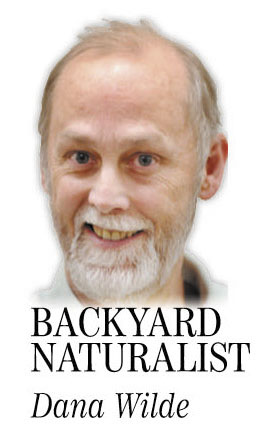The phoebes arrived behind the house in the middle of April, right on schedule, touching up last year’s nest under the back eave. The juncos blew through as usual in March. Robins have been bopping around the treeless area we euphemistically call “the lawn,” different iterations of sparrows appear and disappear, blue jays missile from one edge of the woods to the other, crows cruise overhead like airliners in transit. The purple martins have been chattering like schoolchildren for several weeks in the Unity park. In the last few nights, a barred owl has been quipping from deep in the woods, repeating something meaningful, but we don’t know what.
A bird we see around the backyard only occasionally is the goldfinch. Once or twice in midsummer we might catch a glimpse of bright yellow flickering into the trees, but they’re generally not at home in our landscaping. The house is surrounded by firs, hemlocks, old pines and a mix of deciduous trees, some 40 and 50 feet tall by now. The American goldfinches (Carduelis tristis) that are otherwise pretty abundant hereabouts prefer more open, weedy areas like fields or the woods edge.
So it took me by surprise last week when two goldfinches — a bright yellow male and drab gray-olive colored female — were popping from branch to branch along the brook, deep inside the tree canopy. At first I guessed they were finding the black-fly pickings good (if humans could eat flies, our grocery bill would plummet in May because they spawn like tiny orcs in that running water). But on checking with the guides, it turns out goldfinches are pretty strict vegetarians. They eat mostly seeds, especially from thistles, milkweed and asters like sunflowers, and also from trees like alders and birches, which are abundant along the brook. They eat some fruits, and only rarely a small insect or spider.
The male’s bright yellow feathers, punctuated by black on the wings and head, result from a spring molt in preparation for mating season. The unusual aspect of goldfinch breeding is that mating and nesting take place in late June and July, even August, weeks later than most other birds. It’s thought that this makes sense for the goldfinches because the seeds, their main food, are most abundant later in the summer. The bright yellow on the males is seen mainly from now into July. After that they go through a second molt, unusual among finches, and return to their duller overwintering colors.
Goldfinch females tend to return to the site of last year’s nest — and they can live to be 7 or 8, even up to 11 years by some observations. For a new nest, a pair selects the site together, then the female builds the nest in the fork of a shrub or tree. She uses small root fibers and stems, carefully lines the inside with thistledown, and strengthens it with spider and caterpillar silk to a tightness that can actually hold water.
The male guards the nest early in the process, and later brings food to the female to give to the hatchlings. Pretty soon the male is providing all the food, and sometimes, if the project is a success, the female will leave the first mate to care for the nestlings even before they fledge in about two weeks, to find another mate and produce a second brood. The ornithologists have not figured out exactly how or why these nesting — and cuckolding — patterns work.
Goldfinches have always seemed to me like particularly chipper little birds, not just by the flashing summer yellow, but also by their dance among the shrubs and especially the chatter and singing that go with it. Their song phrases are unusually long and varied, and one guide notes that paired goldfinches develop almost identical flight calls, which suggests that fascinating probability that complex kinds of information are exchanged in ways incomprehensible to us. We tend to be pretty self-congratulatory about our superior language capabilities, while the goldfinches meanwhile are outsinging us all. Except possibly the martins. Or the song sparrows. Or that mysterious barred owl.
Dana Wilde lives in Troy. You can contact him at naturalist1@dwildepress.net. Backyard Naturalist appears the second and fourth Thursdays each month.
Send questions/comments to the editors.



Success. Please wait for the page to reload. If the page does not reload within 5 seconds, please refresh the page.
Enter your email and password to access comments.
Hi, to comment on stories you must . This profile is in addition to your subscription and website login.
Already have a commenting profile? .
Invalid username/password.
Please check your email to confirm and complete your registration.
Only subscribers are eligible to post comments. Please subscribe or login first for digital access. Here’s why.
Use the form below to reset your password. When you've submitted your account email, we will send an email with a reset code.